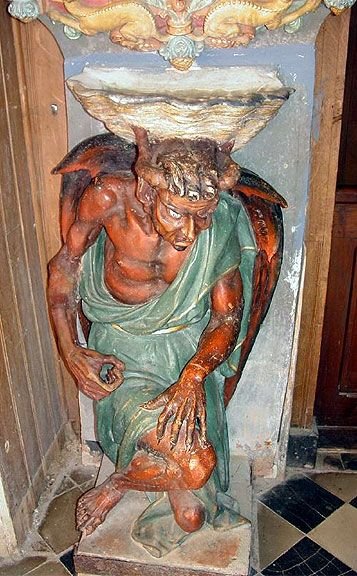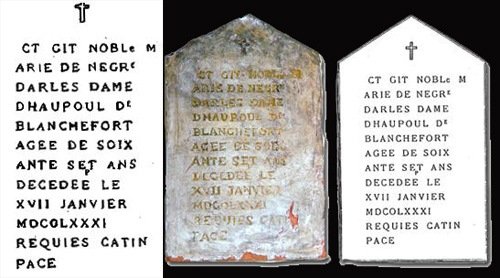The Mystery of Berenger Saunière and the Legend of the Hidden Treasure of Rennes-le-Chateau
Disclaimer
The intention of this content is to expand awareness about certain places, myths and stories told at some point by humanity. Much of the information may not be scientifically supported or may contradict current theories. Knowledge, throughout history, is constantly updated, constructed or replaced when there is greater understanding. Therefore, we want to build a serious approach, within free thought, and in its use in a beneficial way for collective evolution. If you like this content, please consider to follow us on Instagram and Youtube for more.
Introduction
Hello Seekers! I've just returned from an incredible trip through Iberia and the Pyrenees in search of traces of the Templars' presence and the famous legend of the Holy Grail in Europe, but one place in particular caught my attention:
Rennes-le-Chateau.
Obviously, there is an immense amount of content about all the experiences I had there, but if you follow us, you will possibly see them all here. In this one, we will explore the mysteries of the small citadel of Rennes-le-Chateau and its relationships with the Templars and even with the legend of the Holy Grail.
Taking a shortcut, there is a rather famous story that in Rennes-le-Chateau a treasure of immeasurable value was found. Who found this incredible treasure was a man named Berenger Saunière, a humble representative of the church who was sent to the place with the mission of rebuilding an old chapel attributed to Saint Mary Magdalene.
The story is so famous that it gave rise to several bestsellers, including the famous “Da Vinci Code”. Of course, the story there is just a fiction, but it has gathered facts and names from the real story that we are going to tell here.
Saunière's Journey
Saunière was an envoy of the Catholic Church of little means who was assigned to preach, care for and renovate the small church of St. Mary Magdalene. The province where the Chateau is located, is not just any place in history. In addition to having been the scene of the presence of the Celts for millennia, it was also, demonstrably, the ground of mysterious orders and Templar and Cathar missions.
If you don't know what that means, let's keep it simple: The Celts, Templars and Cathars were bearers of great knowledge and treasures not yet completely understood and revealed. For example, it is believed that the Visigoths who inhabited this region would have in their hands great treasures plundered directly from Jerusalem by Emperor Titus, when the Visigoths invaded and sacked Rome during the fall of the Roman Empire.
The treasures of Titus, plundered from Jerusalem (70 AD)
In addition, oral traditions tell that the Templars and Cathars were also defenders of an alleged treasure. This treasure, possibly the Holy Grail, was explored by us in another content that you can check out here.
Returning to Saunière, it is known that the priest, during a restoration work on the church, began to find some very old and mysterious clues left by the former builders of the place. Some even speculate that Saunière was sent by "unknown men" to Rennes-le-Chateau for this preconceived purpose.
Among the clues found by the priest are:
A mysterious set of documents, hidden in a false bottom of a wooden baluster,
A mysterious tombstone below the main altar, with a figure of the Knights Templar and one of Mary Magdalene,
One or more crypts with as yet unknown relics.
Saunière's meteoric rise
Mysteriously, Saunière, after proceeding with the exploration and restoration work on the site, began to become incredibly rich, even with the large expenditures on the site. It is proven that Saunière received substantial donations from people linked to the nobility, from the faithful and through his brother, who was a kind of representative and financier for his work. But what is quite questionable is that the amount of money went far beyond simple donations.
Saunière began work on the construction of what is now the entire location of Villa Bethania, with a small castle with a beautiful garden, a tower dedicated to Mary Magdalene, and the complete restoration of the church. Saunière became the owner of works of art and financier of artists who covered the place with hundreds of mysterious figures and drawings.
From this undertaking, rumors began to emerge that Saunière had unearthed a treasure. How could a simple man get so much money in such a short time? The meteoric rise began to arouse suspicion not only among the local population, who said the priest was violating tombs in a cemetery within Church property, but among the clergy close to Saunière.
The Mysterious Connections and Symbolisms of Rennes-le-Chateau
Rennes-le-Chateau's history gets especially weird once you start looking into the details. In addition to all the mystery already proven by Saunière's sudden enrichment and the connection of the place with mystical orders and relic bearers, the Father made a point of leaving many puzzles and mysteries in the way of its construction and restoration.
Saunière seems to have done this to somehow warn someone or a specific group about his findings. We remind newcomers here that allegory and symbolism are an especially useful way of getting a message across to those who matter, dodging the most superficial looks and avoiding the persecution that was very common at the time. Let's look at some of that symbolism here:
The Saints inside the Church of Madalena
Saunière strangely arranged the saints within the Church of Magdalene following a somewhat original sequence. The initials of each one form the word GRAAL, (Saint Germain, Saint Roch, Saint Anthony of Egypt, Saint Anthony of Padua and Saint Luke), with Maria Madalena in the middle. Was it just a coincidence, or a message for the most attentive?
The Templar Tombstone
The Templar Tombstone found by Saunière under the altar is quite curious, too. On one side, a rather faint figure shows what appears to be a veiled woman, mounted on a mule, carrying an object. Some speculate that she is a newborn, others a relic. On the other side, the figure appears clearer, showing two men mounted on a horse. Although quite strange, this sign is clearly indicative of the Templar presence and common seal of the Order of the Knights of Christ.
The Devil at the Door
I was quite surprised when I saw a huge devil to the left of the church entrance! Usually these figures are not common in these places. After an attentive tour, we discovered that the statue would be more of a carefully constructed symbolism to show the “Map” of the region.
Above the head is the baptismal font with the water source of the entire region. The hands indicate two different places: the Circle of Rennes Le Bains and the Tombstone of Marie de Negre d`Ables in a curious play on words of the hand and the knee (Cinq Genou = Saint Genou) meaning the date of her death. Even the sitting position indicates a stone from the region that is known as the "Devil's Throne". Was it more a coincidence, or a treasure map?
“Et in Arcadia Ego”
A work of art by Nicolas Poussin especially attracted the attention of Saunière, who went to the Louvre himself to buy a copy of it: The Shepherds of Arcadia (Les Bergers d'Arcadie).
The Work of Art is allegedly set in the Rennes-le-Bains region and shows a huge tomb that reads “I was (or am) in Arcadia too”. The most incredible thing is that this tomb actually existed until the 1980s, when it was “destroyed” for attracting a legion of onlookers to the place.
In the future we intend to make another content talking more about this, but what is immediately asked here is: Whose tomb was it? What does this mysterious inscription and its connection with the strange characters in the image mean?
The Cryptogram of Marie de Negre d`Ables
If you enjoy solving secret agent-style puzzles, the story of Rennes-le-Chateau won't let you down. There are a number of cryptograms that were left and discovered here that reveal secret messages. One of them, quite strange is a tombstone of Marie de Negre d'Ables that has several grammatical errors and letters placed out of position. Supposedly these letters reveal yet another clue. Can you decipher?
Blanchefort, Bezu e Rennes-le-Chateau
Lastly, there is a rather strange coincidence, although it is considered just speculation. The locations of Rennes-le-Chateau, and the Templar castles of Blanchefort and Bezù form an almost perfect triangle, with a pentagram on two other peaks in the region (Lauzet and La Soulane). The angles are exactly 72 degrees. Is this more indicative of the secret symbol we see in most of the Templar holy sites? We know that many of the ancient constructions were made using strict principles of sacred geometry.
Saunière's End
As everything that begins has an end, Saunière also ended up having his. The priest, with his projects and discoveries, began to bother some representatives of the Catholic Church a lot. His superiors summoned him, and pressured him in various ways to abandon his personal projects. Wealth was also questioned, which led to intense persecution of Saunière, who was even banned from carrying out his work. Even so, defying the church, the priest continued.
It is unclear what was required of him, but after an avalanche of accusations, trials, punishments, Saunière's health slowly withered to a melancholy death on his estate at the age of 65. He was even offered a pardon, but he declined to remain at Rennes-le-Chateau.
But in the end, what did Saunière discover?
Many have speculated that Rennes-le-Chateau's secret treasure is the Holy Grail itself. The big question is: what is the Grail? Was it special knowledge? A magical stone that bestows powers of plenty and abundance? Could it be a royal lineage that goes back to Jesus of Nazareth himself? What is not clear is how Saunière turned all this into riches. Had he given the treasure to some special person or order?
Another speculation is that Saunière found a Celtic, Cathar or Templar treasure. This treasure could be a special relic that was sold, or simply *lots* of buried gold and silver that are quite common in this region. There are many signs of ancient mines from Roman times until today.
Pierre Plantard, the founder of the Priory of Sion order (which really exists, but maybe it's not what you imagine), was very keen to link the Chateau's history to the designs of a new French order, or perhaps even a world order. Many books and documentaries have been made with this story in mind, but unfortunately it is modern and highly contested. Plantard recently passed away after being discredited and denying the whole story that was created by him in a lawsuit by the French Government.
The great mystery of all the history here is that no one has been able to explain precisely why the clues were left and what was kept and discovered here. More than that, the clues still point to possible other treasures that left (and still leave) the community excited to explore the history of the place, characters and their origins.
Myth is one of the tools to motivate exploration. Countless adventurers set out in search of great treasures and knowledge, and some, even though they didn't find it, found paths, characters and stories that are told and shared to this day. The legend of Saunière and the region of Rennes-le-Chateau is the perfect background for another journey with great learning, and who knows, the discovery of the very treasure that lies within us.
Greetings, and once again, the truth is out there!







